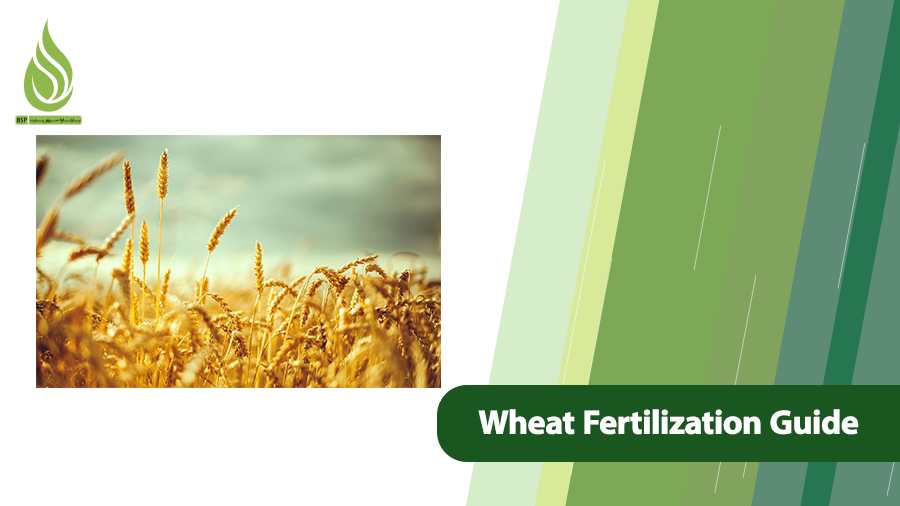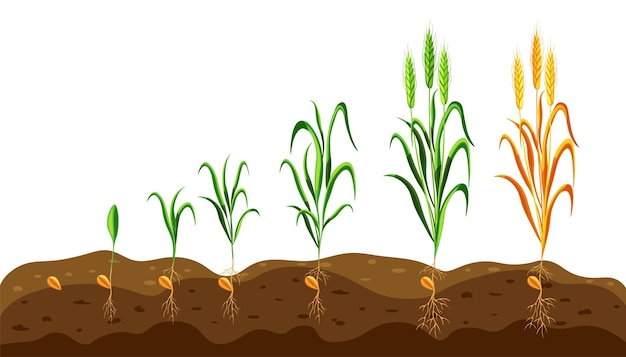
Wheat Fertilization Guide: What Fertilizer & When?
Wheat is the world’s most important grain crop. As a strategic agricultural product, it plays a critical role in ensuring food security. Achieving high yields and quality grains requires more than just proper planting and adequate irrigation—balanced, science-based plant nutrition through fertilization is one of the most crucial factors for healthy growth and maximizing final yields. In this guide, we’ll introduce the essential nutrients wheat needs and provide a fertilization schedule for optimal results. Let’s dive in!
Why Is Fertilization Important for Wheat Yields?
Fertilization is key to improving wheat quality and yield. As one of the world’s most vital crops, wheat significantly impacts global food security. Proper fertilizer use boosts production and enhances grain quality.

Most agricultural soils lack sufficient levels of all the nutrients wheat requires. That’s why applying chemical, organic, and biological fertilizers is essential for maintaining plant health and increasing yields. Knowing which nutrients wheat needs and when to apply them during its growth stages is critical for success.
Essential Nutrients for Wheat Growth
Optimal wheat growth requires both macronutrients and micronutrients. Below, we outline the most critical fertilizers needed for wheat:
- Nitrogen (N): Nitrogen is the most vital nutrient for wheat growth. It supports vegetative growth, leaf development, and increased photosynthesis. Nitrogen deficiency leads to yellowing leaves, stunted growth, and reduced tillering. Common nitrogen fertilizers for wheat include ammonium sulfate and urea.
- Phosphorus (P): Phosphorus promotes root and flower development, accelerates growth, and improves plant quality. A lack of phosphorus results in weak root systems and slowed growth. Common phosphorus fertilizers include simple superphosphate, triple superphosphate, and ammonium phosphate.
- Potassium (K): Potassium enhances disease resistance, regulates water uptake, and improves grain quality. Potassium deficiency may cause leaf scorching and reduced stress tolerance. Common potassium fertilizers are potassium sulfate and potassium chloride.
- Sulfur (S): Sulfur is essential for protein synthesis and improving gluten quality. It also helps reduce soil alkalinity and balance soil pH. Ammonium sulfate fertilizer is a popular choice because it supplies both nitrogen and sulfur, helping control soil pH and salinity while providing nitrogen for early growth.
- Calcium (Ca): Calcium is crucial during the stem elongation stage of wheat growth. It strengthens cell walls, ensuring sturdy stems.
- Micronutrients: Micronutrients are needed in small amounts but are essential for wheat. Key micronutrients include zinc, iron, manganese, copper, boron, and molybdenum. These support germination, root growth, chlorophyll production, and enzyme activation. Micronutrient fertilizers are often applied as foliar sprays.
- Organic Fertilizers: Organic manure improve soil structure and provide a steady release of nutrients, serving as a sustainable source of essential elements. They also enhance soil water retention and improve soil texture. For more details on what organic fertilizers are and their components, click the link.
Wheat Fertilization Schedule

Wheat fertilization is carried out in six key stages:
- Pre-planting
- Rooting and germination
- Tillering
- Stem elongation
- Heading
- Grain filling
Below, we explain the fertilization process for each stage.
Pre-Planting
Before planting, the field must be prepared through tillage and fertilization. At this stage, applying organic fertilizers, such as poultry or cow manure, is essential before sowing wheat seeds. Additionally, base fertilizers containing phosphorus and potassium should be applied to the soil. These fertilizers should be granular and thoroughly mixed into the soil.
Nitrogen fertilizer is also needed at planting. It should be applied a few days before sowing. If using urea, you must separately apply sulfur fertilizer alongside nitrogen. However, if you choose ammonium sulfate, no additional fertilizer is needed. Ammonium sulfate combines sulfur and nitrogen, supplying both nutrients to the soil.
Germination Stage
During this stage, nutrients should be added to the soil to promote better sprout growth and increase their resilience. A balanced NPK fertilizer is ideal at this point. The phosphorus in this fertilizer supports root expansion, while nitrogen boosts leaf growth.
Tillering Stage
Wheat growth begins with a single stem, followed by the development of two or three additional stems around the main stem, a process called tillering. Tillering typically occurs about one month after planting. At this stage, fertilizers that enhance tillering are used, as more tillers lead to higher yields. The best fertilizers for this stage are nitrogen-rich ones, such as urea. Applying iron and zinc fertilizers is also recommended.
Stem Elongation Stage
After tillering, the focus shifts to forming strong stems. Nitrogen-based fertilizers, like ammonium sulfate, are essential during this stage. Micronutrients such as zinc are also recommended. Among all wheat growth stages, stem elongation is the most critical for nitrogen application.
Heading Stage
During the heading stage, nitrogen application should be stopped. The focus should be on promoting greater head development. Potassium fertilizers are the most effective for supporting head growth. Additionally, you can apply micronutrients such as iron, zinc, copper, and manganese as part of your fertilization plan at this stage.
Grain Filling Stage

The best fertilizer for the grain filling stage is one high in potassium. Potassium-rich fertilizers aid in grain filling and strengthen heads. It’s also advisable to use calcium-containing fertilizers as needed. In the final stages of grain development, controlled nitrogen application can boost the protein content of the crop. However, high doses are unnecessary—a balanced NPK fertilizer with high potassium and moderate nitrogen is sufficient.
Key Tips for Wheat Planting and Fertilization
- Soil Testing: Before applying any fertilizer, conducting a soil test to determine nutrient needs and soil pH is crucial. Wheat thrives best in soil with a pH between 6 and 7. Based on the soil test results, you can adjust the soil pH with fertilizers before planting. Accurate soil sampling and testing reveal the nutrient levels in the soil, so it’s essential to test the soil before developing a fertilization plan to address specific deficiencies.
- Split Fertilizer Applications: After receiving soil test results, divide the required fertilizers into multiple applications across different growth stages. For example, if 800 grams of ammonium sulfate is needed, apply it in two or three doses during various growth periods.
- Avoid Over-Fertilization: Just as under-fertilizing reduces agricultural productivity, excessive fertilizer use can harm plants and soil. Always consider the soil’s needs and deficiencies, and apply fertilizers according to the fertilization schedule to address those shortages.
- Water Management: Providing adequate water during all wheat growth stages is critical. Water shortages can negatively affect nutrient absorption.
- Fertilizer Diversity: Using a balanced mix of fertilizers (chemical and organic) can improve soil quality and enhance fertility.
- Consider Cultivar and Location: The information provided here outlines the general needs of wheat. However, fertilization requirements may vary depending on your geographic location, irrigation method, and wheat cultivar. If you lack experience in wheat planting and fertilization, consult an agricultural expert or experienced farmer for guidance.
